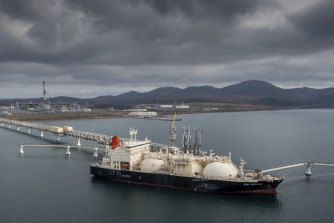Russia can still make payments on Russian sovereign debt as long as it is not trying to use funds from Russian government accounts that are held in US financial institutions.
The most direct verdict could come from the big credit ratings agencies, which have already signalled that Russia’s creditworthiness is eroding and that a default could be on the horizon.
This past week, Moody’s warned that Russia’s payment of about $US650 million ($878 million) of dollar-denominated debt in roubles April 4 could be considered a default if it does not reverse course and pay in dollars by May 4, when a 30-day grace period concludes. That followed a similar warning earlier in the week by S&P Global, which placed Russia under a “selective default” rating.
But it is not clear how the ratings agencies will weigh in if Russia fails to make payments after its grace periods run out because of European Union sanctions that have restricted the agencies from rating Russia. Spokespeople from Moody’s and S&P did not comment. A Fitch spokesperson said he could not offer any comments on Russia’s creditworthiness in light of the sanctions.
The Biden administration put additional pressure on Russia earlier this month when the Treasury Department started blocking Russia from making debt payments using dollars held in US banks. That new restriction was intended to force Russia to choose between draining the remaining dollar reserves it has in Russia or using new revenue (from natural gas payments, for example) to make bond payments and avoid defaulting on its debt.
Russia can still make payments on Russian sovereign debt as long as it is not trying to use funds from Russian government accounts that are held in US financial institutions.
After the grace period on the foreign currency bond payments expires May 4, the next key moment will be May 25. That is when US bondholders will no longer be able to accept Russian debt payments under a temporary exemption that the Treasury Department has allowed.
Loading
Although the verdict of the ratings agencies carries significant weight, bondholders will determine the consequences of Russia failing to make payments that were due or that violate the terms of its contracts. The bondholders could take a wait-and-see approach or declare that the bonds are immediately due and payable, which could cause other bonds with “cross default” provisions to also be in default.
Another potential arbiter of default is the Credit Derivatives Determination Committee, which is a panel of investors in the market for default insurance, or credit default swaps. The committee is deliberating whether Russia’s payments in roubles constitute a “failure to pay,” which would kick-start insurance payouts. The panel already ruled that the state-owned Russian Railways JSC was in default for missing a bond interest payment.
To some analysts, that decision and the payments in roubles mean that Russia already is technically in default.
“If Russia doesn’t pay on time, doesn’t pay in the currency in the contract, that’s a default — it’s crystal clear,” said Timothy Ash, a senior sovereign strategist at BlueBay Asset Management. “For all intents and purposes, Russia is already in default.”
Defaults have been tied up in courts before. Argentina notably defaulted in 2014 after negotiations with hedge funds that refused to accept reduced payments broke down and a federal judge in the United States ruled that it could not make its regular payments on bonds without also paying the hedge fund holdouts. The US Supreme Court declined to hear Argentina’s appeal in the case.
Russia’s case is unique because of the sanctions, and it is expected to argue that its ability to make payments in the currencies in its bond contracts has been constrained because it cannot access all of its reserves.
Ash suggested that it would be difficult for Russia to find a court that is sympathetic with Russia’s position.
“A US court is never going to rule against OFAC,” Ash said, referring to the US Treasury Department’s Office of Foreign Assets Control, which administers the sanctions.

Russia’s total foreign public debt amounts to about $US75 billion ($101 billion), while Russia’s annual energy sales are worth about $US200 billion ($270 billion).Credit:AP
But Samples suggested that, given Russia’s global pariah status, creditors could struggle to pursue Russian assets even if they win a favourable judgment in court.
He predicted that Russia would look for creative ways to avoid acknowledging a default, such as pointing to arcane language in bond contracts that could be interpreted to allow for payments in other currencies or by seeking a friendly court jurisdiction, perhaps in Russia.
“I do expect them to stick to their own alternative facts,” Samples said.
Despite the symbolism of a default, the economic implications for Russia and the world could be relatively small.
Economists estimate that Russia’s total foreign public debt amounts to about $US75 billion ($101 billion), while Russia’s annual energy sales are worth about $US200 billion ($270 billion). Investors have been anticipating a default since late February, and policymakers have suggested that a default does not pose a threat to the stability of the financial system.
Ultimately, the market will determine whether Russia is worthy of credit, and its actions in Ukraine and future sanctions will determine the fate of its economy.
“It feels like garnish and a dressing on top of a very ugly and profound set of circumstances,” said Anna Gelpern, a Georgetown Law professor who specialises in sovereign debt. “They’re drinking from a fire hose as far as the energy revenues, so why do they need to borrow?”
This article originally appeared in The New York Times.








